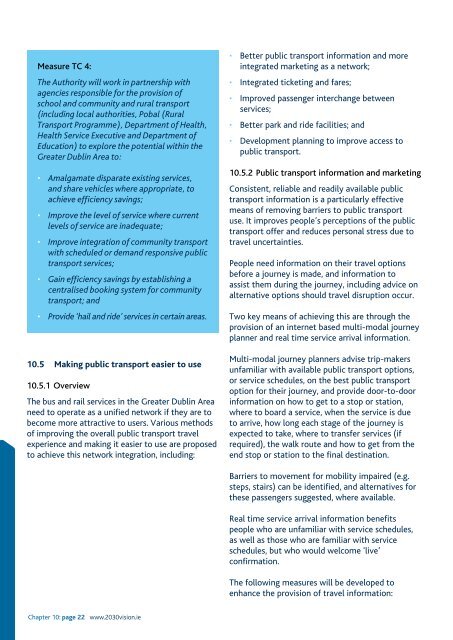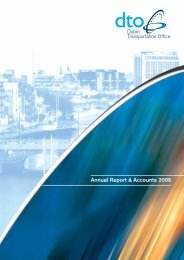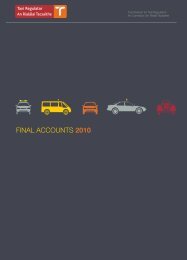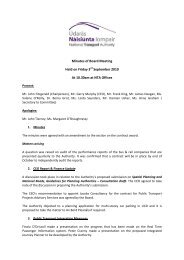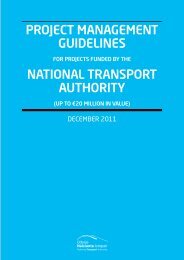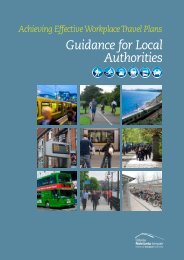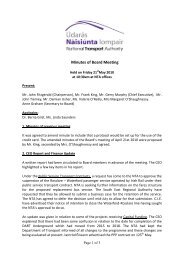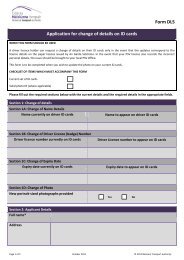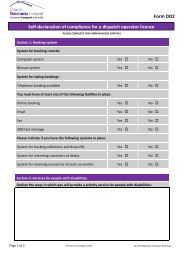Greater Dublin Area Draft Transport Strategy 2011-2030
Greater Dublin Area Draft Transport Strategy 2011-2030
Greater Dublin Area Draft Transport Strategy 2011-2030
- No tags were found...
You also want an ePaper? Increase the reach of your titles
YUMPU automatically turns print PDFs into web optimized ePapers that Google loves.
Measure TC 4:The Authority will work in partnership withagencies responsible for the provision ofschool and community and rural transport(including local authorities, Pobal (Rural<strong>Transport</strong> Programme), Department of Health,Health Service Executive and Department ofEducation) to explore the potential within the<strong>Greater</strong> <strong>Dublin</strong> <strong>Area</strong> to:• Amalgamate disparate existing services,and share vehicles where appropriate, toachieve efficiency savings;• Improve the level of service where currentlevels of service are inadequate;• Improve integration of community transportwith scheduled or demand responsive publictransport services;• Gain efficiency savings by establishing acentralised booking system for communitytransport; and• Provide ‘hail and ride’ services in certain areas.10.5 Making public transport easier to use10.5.1 OverviewThe bus and rail services in the <strong>Greater</strong> <strong>Dublin</strong> <strong>Area</strong>need to operate as a unified network if they are tobecome more attractive to users. Various methodsof improving the overall public transport travelexperience and making it easier to use are proposedto achieve this network integration, including:• Better public transport information and moreintegrated marketing as a network;• Integrated ticketing and fares;• Improved passenger interchange betweenservices;• Better park and ride facilities; and• Development planning to improve access topublic transport.10.5.2 Public transport information and marketingConsistent, reliable and readily available publictransport information is a particularly effectivemeans of removing barriers to public transportuse. It improves people’s perceptions of the publictransport offer and reduces personal stress due totravel uncertainties.People need information on their travel optionsbefore a journey is made, and information toassist them during the journey, including advice onalternative options should travel disruption occur.Two key means of achieving this are through theprovision of an internet based multi-modal journeyplanner and real time service arrival information.Multi-modal journey planners advise trip-makersunfamiliar with available public transport options,or service schedules, on the best public transportoption for their journey, and provide door-to-doorinformation on how to get to a stop or station,where to board a service, when the service is dueto arrive, how long each stage of the journey isexpected to take, where to transfer services (ifrequired), the walk route and how to get from theend stop or station to the final destination.Barriers to movement for mobility impaired (e.g.steps, stairs) can be identified, and alternatives forthese passengers suggested, where available.Real time service arrival information benefitspeople who are unfamiliar with service schedules,as well as those who are familiar with serviceschedules, but who would welcome ‘live’confirmation.The following measures will be developed toenhance the provision of travel information:Chapter 10: page 22 www.<strong>2030</strong>vision.ie


